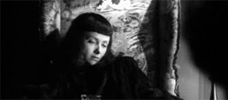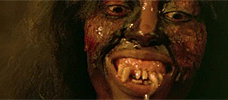Reviews
Amy Holden Jones
USA, 1982
Credits
Review by Megan Weireter
Posted on 26 October 2009
Source bootleg DVD
Categories 31 Days of Horror VI
I am a woman, and I am a feminist—and I totally, totally love slasher movies. I love all the cheap thrills in a slasher: the stupid scare chords, the fake scares (oh, whew, it was just a cat!), the hilariously gratuitous nudity, and the needlessly elaborate placing of corpses just where the Final Girl is going to be startled by them as she runs screaming into the darkness. Slashers are by definition formulaic; they don’t require much on the part of the viewer, which makes them weirdly comforting to watch, no matter what one’s gender or political leanings might be.
And yet we have been told that slashers are sexist and gross, that the only reason these films exist is to cater to a misogynist culture that derives sick sexual pleasure from watching women die (no matter that tons of men end up dying too, most of the time). This argument is a large part of why slashers were so reviled critically during their heyday in the ’70s and ’80s. And even though contemporary film criticism has to some extent drifted toward a more nuanced position on gender in horror (this summary of Carol Clover’s groundbreaking 1992 book Men, Women, and Chainsaws is a good read if you want to see what I’m talking about), we still have to contend with articles like this recent masterpiece of inanity from the New York Times, which asks the question of why women like horror films with myopic befuddlement—as if women couldn’t possibly watch scary movies for the same reasons men do.
The Slumber Party Massacre was conceived as a parody of the slasher and its gender dynamics (as they were interpreted in the early ’80s, of course) by screenwriter Rita Mae Brown, a lesbian activist and novelist. In the years that followed, Brown complained that her satirical script was stripped of its satire by a studio that was more interested in luring in the usual horror movie target market of teenage boys than in making some kind of feminist commentary. But her complaint misses the mark. Maybe this isn’t the movie that Brown envisioned when she was writing it, but under the earnest direction of Amy Holden Jones, The Slumber Party Massacre turned out to be a whip-smart slasher that totally works as both a genuinely well-done cheapie slasher film and as a twist on the standard slasher psychology. There is still plenty of satire here, but it’s affectionate, gentle satire—not really genre-busting, as Brown perhaps intended it to be. Indeed, its cleverness actually makes it much more fun than many inferior slashers, and in the end it’s more likely to bring new fans into the fold than convince anyone that the whole genre is worthless. The Slumber Party Massacre gives slasher fans every single thing they could possibly want from this genre, with a ton of bonus wit that makes viewers feel smart and the film feel like a ton of fun. And that’s something you just don’t get every day.
The setup is simple: Trish’s parents are going out of town, and she’s throwing a slumber party for a small group of her close friends. Just a few girlfriends from the basketball team, plus booze and pot and laughs. It’s not necessarily Trish’s fault that some of the boys from school crash the party—not that anyone tries too hard to make them leave. But predictably, things go awry. There’s a crazed killer on the loose, and he’s chasing down teenagers to kill them with about the least subtle murder weapon you’ve ever seen—a gigantic drill. (Just to make sure you’re not missing anything here, the cover of the DVD is a shot between the killer’s legs, the gigantic drill hanging suggestively between them as women cower in fear before it. It actually echoes a similar shot from the film.)
Refreshingly, the killer is just that—The Killer. He’s not masked, and he’s not burdened with any of the convoluted back stories of the Jason Voorheeses of the film world. In fact, the entirety of his story is that he’s a crazed killer on the loose, and once that’s put out there, we can get right to the killings. A nondescript, middle-aged guy with a predilection for denim and that unforgettable gigantic drill, he stalks through the film with an expression not dissimilar to the faces of the (basically harmless and stupid) teenage guys who ogle the girls at the slumber party through a window—the ultimate sexual predator.
And though the killer is obviously good for real scares here and there, few movies treasure the fake scare as much as The Slumber Party Massacre—the movie is rife with them, and since fake scares are great for comedy, you find yourself laughing through much of the movie. Just to get us in the mood, the film opens with a fairly clever fake scare: we hear a horrible scream (!!!) that’s revealed to be a woman on the radio, screaming with excitement because she’s won some contest. At one point, we learn that the kindly next door neighbor actually kills pesky little garden snails with a machete—a fact that’s revealed entirely in service of the fake scare of the machete glinting in the light while the music crescendos before coming down - WHAP - on a snail. It is ridiculous over-commitment to a bit. And there’s a lot more overt comedy all over the place, too. Many of the deaths themselves are shown with a flair for the dramatic that’s very appealing—especially the death of the poor pizza guy. My favorite moment of comedy is towards the end, though: just count the number of times a person can not notice a corpse in a refrigerator. It gets funnier each time.
Slasher movies, which almost always feature teenagers slaughtered just as they’re beginning to taste the freedoms of adulthood, play upon the anxieties of adolescence, and The Slumber Party Massacre shows a knowingness about this from the start. The opening scenes have Trish waking up the morning of the party and beginning to throw away some of her old children’s toys and stuffed animals. She sweeps them off her dresser with both determination and a kind of sadness on her face—ultimately, she can’t help but keep one or two animals as tokens of her childhood, and of course this is all shorthand for how she’s (nervously, awkwardly) Becoming a Woman. (As you can see, this stuff is handled with all the subtlety you’d expect from the movie that features a gigantic drill. Another non-subtle touch: someone steals away a Barbie doll Trish throws away from the top of the trash can. You can bet that Barbie becomes important to the plot later on.) Trish’s unease with the transition into adulthood is made all the more clear by her repeated insistence that the slumber party is to be just herself and her three best friends from childhood—“like old times.” It’s everyone else who seems to want to ruin it by bringing boys into the picture. Of course, teetering at the verge of adulthood as all of these characters are puts them at a vulnerable place, one at which a killer with a drill could easily pick them off.
Slashers frequently are criticized for the reactionary way they tend to punish moral transgressors, but in The Slumber Party Massacre, everyone is fair game, regardless of their sex lives or drug use. The first victim is an attractive woman, sure—but she’s an adult, a phone technician, who wears a hard hat and succinctly shoots down a meathead teenager who hits on her. (This is a good kill—a genuine surprise.) And the next victim is actually a girl who’s too good to even go to the slumber party, a girl so good that she’s planning to stay at home on a Friday night and study instead.
The whole issue of moral transgression, in fact, is thrown into question here, in a way that’s tied up with its exploration of adolescence. It’s not as easy as it usually is in these movies to file away each of the characters here as good or bad. Most of the female characters are on the basketball team, which seems like a deliberate choice—they could just have easily have been cheerleaders (as they are in Cheerleader Massacre, one of this movie’s vastly inferior sequels), and that would have signified something completely different. Also of note is that this film gives us two Final Girls (maybe three, if you count a preteen among them), and both of them have been shown to be less than pure. One of them has been smoking pot and drinking at the slumber party, while the other, Valerie, has spent much of the movie looking at her stash of Playgirls. And we’ve seen them both naked already (there being enough gratuitous nudity here to please even the raunchiest slasher fan), which frequently significantly decreases a woman’s chance of surviving this kind of movie.
In many ways Valerie, who is picked on by all the others and spends this Friday night in the house next door to the party babysitting her little sister (who’s totally a future Bad Girl in the making), is set up as the archetypical horror movie Good Girl, but her snarkiness to her sister and, of course, her Playgirls make her more complex than that (or as complex as the standard-issue B-movie dialogue can make her out to be). Likewise, Diane, who’s more interested in having sex with her boyfriend seemingly every minute of the day than in hanging out with her girlfriends, is set up as a classic Bad Girl. But Diane’s sin isn’t just the standard sin of having sex before marriage. We get the sense that her real sin is running out on her girlfriends for a boy.
In fact, the fact that Trish makes it to the end of the film despite her own sins is likely a testament to her loyalty to her friends and to her own childhood. The stuff about sex and drugs is really just noise, after all, and simply indulging in these vices doesn’t in itself defile the characters. Indeed, the film treats this stuff matter-of-factly as a part of growing up. What’s really crucial to the process of growing up, though, is figuring out how to assert yourself against Every Man, embodied here in the nondescript killer. Our two Final Girls do eventually figure that out, in a finale whose lack of subtlety makes the rest of the film look practically understated (hint: symbolic castration!). But fortunately for us, The Slumber Party Massacre balances its bloated symbolism and its more serious satirical goals with a healthy respect for the slasher genre and a boatload of blood, gore, and fun. This might not have been the movie the screenwriter had in mind, but I think in the end it might be quite a bit better.
More 31 Days of Horror VI
-

From Beyond
1986 -

The Haunting
1963 -

Killer Klowns from Outer Space
1988 -

Shock ‘Em Dead
1991 -

Critters
1986 -

Critters 2
1988 -

The Fall of the House of Usher
1928 -

Jonestown: The Life and Death of Peoples Temple
2006 -

In the Mouth of Madness
1994 -

Winterbeast
1991 -

Black Roses
1988 -

Needful Things
1993 -

The Seventh Victim
1943 -

A Page of Madness
1926 -

Holocaust 2000
1977 -

The Man and the Monster
1958 -

The Texas Chainsaw Massacre 2
1986 -

Trick or Treat
1986 -

Single White Female
1992 -

Trouble Every Day
2001 -

The Hands of Orlac
1924 -

The Devil’s Advocate
1997 -

Nocturne
1998 -

Hardware
1990 -

Hard Rock Zombies
1985 -

The Slumber Party Massacre
1982 -

Saw VI
2009 -

Zombi 4: After Death
1988 -

The Uninvited
1944 -

Hausu
1977
We don’t do comments anymore, but you may contact us here or find us on Twitter or Facebook.



